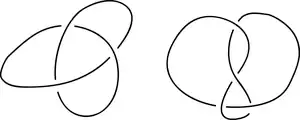Connected sum
In mathematics, specifically in topology, the operation of connected sum is a geometric modification on manifolds. Its effect is to join two given manifolds together near a chosen point on each. This construction plays a key role in the classification of closed surfaces.

More generally, one can also join manifolds together along identical submanifolds; this generalization is often called the fiber sum. There is also a closely related notion of a connected sum on knots, called the knot sum or composition of knots.
Connected sum at a point
A connected sum of two m-dimensional manifolds is a manifold formed by deleting a ball inside each manifold and gluing together the resulting boundary spheres.
If both manifolds are oriented, there is a unique connected sum defined by having the gluing map reverse orientation. Although the construction uses the choice of the balls, the result is unique up to homeomorphism. One can also make this operation work in the smooth category, and then the result is unique up to diffeomorphism. There are subtle problems in the smooth case: not every diffeomorphism between the boundaries of the spheres gives the same composite manifold, even if the orientations are chosen correctly. For example, Milnor showed that two 7-cells can be glued along their boundary so that the result is an exotic sphere homeomorphic but not diffeomorphic to a 7-sphere.
However, there is a canonical way to choose the gluing of and which gives a unique well-defined connected sum.[1] Choose embeddings and so that preserves orientation and reverses orientation. Now obtain from the disjoint sum
by identifying with for each unit vector and each . Choose the orientation for which is compatible with and . The fact that this construction is well-defined depends crucially on the disc theorem, which is not at all obvious. For further details, see.[2]
The operation of connected sum is denoted by .
The operation of connected sum has the sphere as an identity; that is, is homeomorphic (or diffeomorphic) to .
The classification of closed surfaces, a foundational and historically significant result in topology, states that any closed surface can be expressed as the connected sum of a sphere with some number of tori and some number of real projective planes.
Connected sum along a submanifold
Let and be two smooth, oriented manifolds of equal dimension and a smooth, closed, oriented manifold, embedded as a submanifold into both and Suppose furthermore that there exists an isomorphism of normal bundles
that reverses the orientation on each fiber. Then induces an orientation-preserving diffeomorphism
where each normal bundle is diffeomorphically identified with a neighborhood of in , and the map
is the orientation-reversing diffeomorphic involution
on normal vectors. The connected sum of and along is then the space
obtained by gluing the deleted neighborhoods together by the orientation-preserving diffeomorphism. The sum is often denoted
Its diffeomorphism type depends on the choice of the two embeddings of and on the choice of .
Loosely speaking, each normal fiber of the submanifold contains a single point of , and the connected sum along is simply the connected sum as described in the preceding section, performed along each fiber. For this reason, the connected sum along is often called the fiber sum.
The special case of a point recovers the connected sum of the preceding section.
Connected sum along a codimension-two submanifold
Another important special case occurs when the dimension of is two less than that of the . Then the isomorphism of normal bundles exists whenever their Euler classes are opposite:
Furthermore, in this case the structure group of the normal bundles is the circle group ; it follows that the choice of embeddings can be canonically identified with the group of homotopy classes of maps from to the circle, which in turn equals the first integral cohomology group . So the diffeomorphism type of the sum depends on the choice of and a choice of element from .
A connected sum along a codimension-two can also be carried out in the category of symplectic manifolds; this elaboration is called the symplectic sum.
Local operation
The connected sum is a local operation on manifolds, meaning that it alters the summands only in a neighborhood of . This implies, for example, that the sum can be carried out on a single manifold containing two disjoint copies of , with the effect of gluing to itself. For example, the connected sum of a 2-sphere at two distinct points of the sphere produces the 2-torus.
Connected sum of knots
There is a closely related notion of the connected sum of two knots. In fact, if one regards a knot merely as a 1-manifold, then the connected sum of two knots is just their connected sum as a 1-dimensional manifold. However, the essential property of a knot is not its manifold structure (under which every knot is equivalent to a circle) but rather its embedding into the ambient space. So the connected sum of knots has a more elaborate definition that produces a well-defined embedding, as follows.



This procedure results in the projection of a new knot, a connected sum (or knot sum, or composition) of the original knots. For the connected sum of knots to be well-defined, one has to consider oriented knots in 3-space. To define the connected sum for two oriented knots:
- Consider a planar projection of each knot and suppose these projections are disjoint.
- Find a rectangle in the plane where one pair of sides are arcs along each knot but is otherwise disjoint from the knots and so that the arcs of the knots on the sides of the rectangle are oriented around the boundary of the rectangle in the same direction.
- Now join the two knots together by deleting these arcs from the knots and adding the arcs that form the other pair of sides of the rectangle.
The resulting connected sum knot inherits an orientation consistent with the orientations of the two original knots, and the oriented ambient isotopy class of the result is well-defined, depending only on the oriented ambient isotopy classes of the original two knots.
Under this operation, oriented knots in 3-space form a commutative monoid with unique prime factorization, which allows us to define what is meant by a prime knot. Proof of commutativity can be seen by letting one summand shrink until it is very small and then pulling it along the other knot. The unknot is the unit. The two trefoil knots are the simplest prime knots. Higher-dimensional knots can be added by splicing the -spheres.
In three dimensions, the unknot cannot be written as the sum of two non-trivial knots. This fact follows from additivity of knot genus; another proof relies on an infinite construction sometimes called the Mazur swindle. In higher dimensions (with codimension at least three), it is possible to get an unknot by adding two nontrivial knots.
If one does not take into account the orientations of the knots, the connected sum operation is not well-defined on isotopy classes of (nonoriented) knots. To see this, consider two noninvertible knots K, L which are not equivalent (as unoriented knots); for example take the two pretzel knots K = P(3, 5, 7) and L = P(3, 5, 9). Let K+ and K− be K with its two inequivalent orientations, and let L+ and L− be L with its two inequivalent orientations. There are four oriented connected sums we may form:
- A = K+ # L+
- B = K− # L−
- C = K+ # L−
- D = K− # L+
The oriented ambient isotopy classes of these four oriented knots are all distinct, and, when one considers ambient isotopy of the knots without regard to orientation, there are two distinct equivalence classes: {A ~ B} and {C ~ D}. To see that A and B are unoriented equivalent, simply note that they both may be constructed from the same pair of disjoint knot projections as above, the only difference being the orientations of the knots. Similarly, one sees that C and D may be constructed from the same pair of disjoint knot projections.
Further reading
- Robert Gompf: A new construction of symplectic manifolds, Annals of Mathematics 142 (1995), 527–595
- William S. Massey, A Basic Course in Algebraic Topology, Springer-Verlag, 1991. ISBN 0-387-97430-X.
References
- Kervaire and Milnor, Groups of Homotopy Spheres I, Annals of Mathematics Vol 77 No 3 May 1963
- Kosinski, Differential Manifolds, Academic Press Inc (1992).